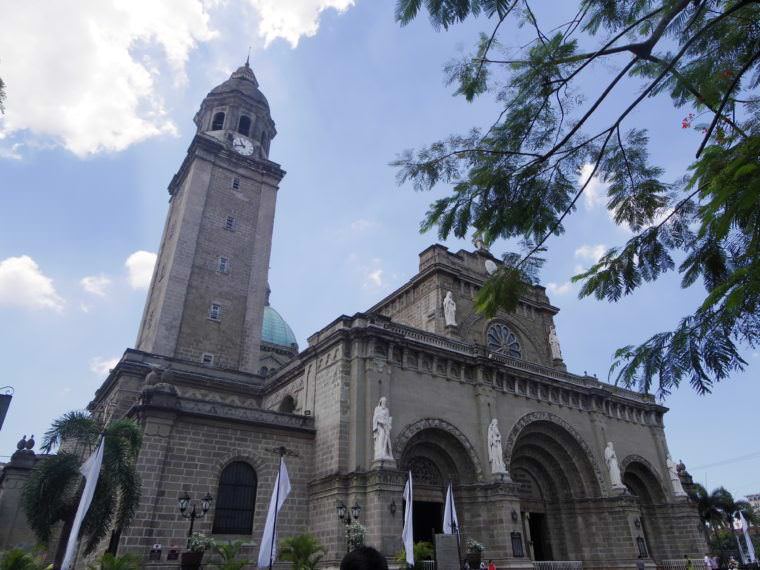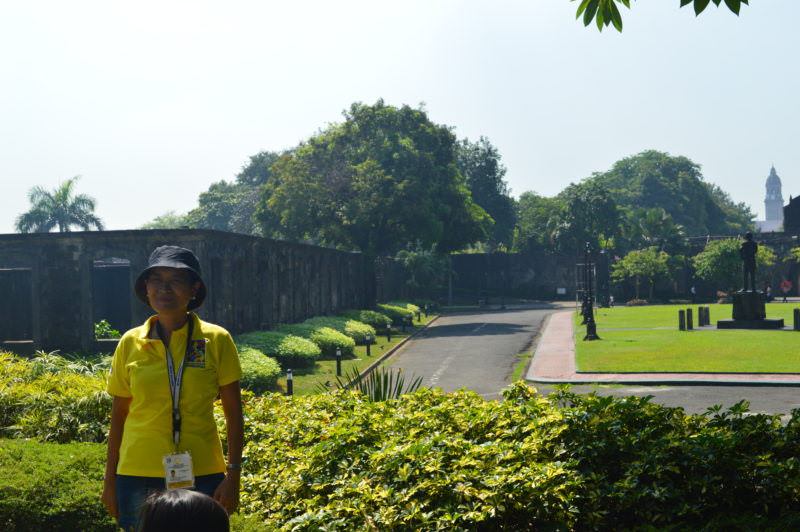Our Itinerary and Travel Guide to Intramuros and Binondo in Manila, Philippines
Travelling to Intramuros is a great way to appreciate the rich history of the Philippines. Intramuros was built 300 years ago by Spaniards when the Philippines was still a colony of Spain. It is the original Manila enclosed within the walls. While my friends and I are Filipinos, we’re glad that we hired a personal tour guide as it made our trip more convenient and informative. Otherwise, our trip will be merely sightseeing.


We started our trip at Fort Santiago. Entrance fee is Php 75.00 per head. Fort Santiago is the defense fortress of Intramuros and was used as a storage for gun powders and jail for prisoners. Jose Rizal, the Philippines national hero, was imprisoned here before he was executed. Normally, Fort Santiago can be explored less than 1 hour but it took us approximately 2 hours to explore it because our tour guide gave us lots of interesting stories. I felt like going back in the past. Lol!
- 10 Resorts Near Metro Manila for Team Building & Company Outings
- Metro Manila – 10 Weekend Getaways near Metro Manila
- 20 Towns and Cities You Must Visit in Mindanao [Philippines]
- Travel Guide to Popular Cities in the Philippines – 25 Day Trips That You Can Do in the Philippines
- Complete Guide to Car Rental & Driving in the Philippines (for Foreigners)


Inside the Fort Santiago is also Rizal Shrine, a museum displaying different memorabilia related to Jose Rizal.

After Fort Santiago, we went to Plaza de Roma and Manila Cathedral. During the Spanish times, the plaza was considered as the center of the city where public events are held. Now, a statue of King Charles IV of Spain can be seen in the middle of the plaza in honor of him sending the first smallpox vaccine to the Philippines.

The Manila Cathedral is the premier church and the first cathedral of the Philippines. It was rebuilt multiple times after suffering from different natural disasters and being a victim of war. Note that you need to take off your hats before going inside the church as a sign of respect.


After Manila Cathedral, we went to San Agustin Church. It is the only church in Intramuros which survived World War II. Interestingly, at the entrance of the church are Foo dogs or Chinese guardian lions. According to our tour guide, the church was built by Chinese laborers which are the reason why certain features of the church show Chinese influences.



Part of the San Agustin Church is the San Agustin Museum where different artistic works of historical and cultural significance can be seen. Entrance fee is Php 200.00 per head. The museum is perfect for those who enjoys arts and/or other historical artifacts but can be boring for those looking for more active experiences.

My friend, Kisse, who loves going to churches had a good time here. We have to wait for her most of the times because she stays too long in one place before moving to the next room. Lol! Note that the museum closes during lunchtime at 12 PM – 1 PM.

And to complete our trip, we also visited Casa Manila just across San Agustin Church. Entrance fee is Php 75.00 per head. Casa Manila is a museum depicting the lifestyle of the rich Filipino families in the past.
Although exhausted from the hot weather, we enjoyed traveling to Intramuros. To maximize our day, we also did a Binondo Food Trip after our Intramuros Tour. We had our lunch at Binondo, the World’s Oldest Chinatown, just across Intramuros.
If you’re planning to visit Intramuros, here is a copy of our itinerary for your reference:
8:30 AM – Meetup at Fort Santiago / Start of Intramuros Tour
10:30 AM – Plaza Roma
10:40 AM – Manila Cathedral
11:00 AM – San Agustin Church & Museum
12:00 AM – Casa Manila
12:30 PM – End of Intramuros Tour / To Binondo

After our Intramuros Tour, my friend and I decided to have a Binondo Food Trip as Binondo is just across Intramuros. Binondo is the World’s Oldest Chinatown. It was granted by the Spanish government, when the Philippines was still a colony of Spain, as a permanent settlement to the Chinese immigrants who converted to Catholicism.

We’re all hungry by this time (it was around 1PM already) so we had our lunch first at Quik Snack. Located along the narrow street of Carvajal, Quik Snack is a bit difficult to find. Luckily, we have a tour guide to navigate for us. The humble restaurant serves affordable home-cooked Chinese meals with huge servings.


For appetizer, we had their Fresh Lumpia and Lumpia Quitos. Lumpia Quitos is almost similar in taste to Fresh Lumpia but it’s serve on a bite size crusty wrapper and is more juicy.

My favorite orders at Quick Snack are Amah’s Kiampong and the Indonesian Tauhu. The kiampong tastes authentic and the tofu is flavorful. They’re almost a perfect match. By the way, Amah is a Chinese term for grandmother on the father side.

On the other hand, my friends really enjoyed the spicy Sate Beef Noodles. But beware of its serving size as its really huge. One order of it can be good for like around 5 persons.

After eating lunch, we walked our way to Binondo Church to digest all the food we ate. Lol! The pagoda-like belfry of the Binondo church is an evidence of the Chinese influences to the Catholic church.


After visiting Binondo Church, we resumed our food trip and went to Dong Bei Dumplings. Dong Bei Dumplings served northern-style Chinese handmade dumplings. We were lucky to witness how the Kuchay Dumplings are made in action.

We also passed by to an altar where you can see how the different religions merged at Binondo. The altar is presented with a cross in the middle but you can use incense sticks to pray.

Our walk lead us to Po Chuan Tin Bakery, a traditional bakery which serves traditional hopia.

We also tried Shanghai Fried Siopao and it’s really good. The bottom part of its siopao is fried hence the name.

The long walk and the hot weather has made us thirsty. Fortunately, just on time, we reached the Sugarcane Vendor where we had a cold and sweet Sugarcane Juice. The juice is made from real sugarcane.


Since it’s almost time for an afternoon snack break, we ended our trip at Wai Ying Fastfood where we had some dim sums. Dim sum is a Chinese term for a snack.
While we have a list of target shops/restaurants to try at Binondo, we didn’t really have a fixed itinerary for our food trip as we just went along the flow with our tour guide.
Here’s a picture of our tour guide, Ms. Chit. Aside from being a Department of Tourism accredited tour guide, I learned that she is also a college professor. You can contact her through these numbers 09195854187/09228577027.

![]()
About the Writer
 Hi! I’m Regine. I’m a software developer by profession and a blogger by hobby. I enjoy eating different foods and being at peace with nature. Check me out at WhatsUp.ph or follow me on Facebook.
Hi! I’m Regine. I’m a software developer by profession and a blogger by hobby. I enjoy eating different foods and being at peace with nature. Check me out at WhatsUp.ph or follow me on Facebook.
![]()
Are you on Pinterest? Pin these!





Thanks for the guide! These places serve a lot of cultural value for us Filipinos so it’s nice to go around and visit them every once in a while.
I have two visitors from the USA and would like to avail of the Intramuros and Binondo tours on 4 March 2020. In view of this, may I get your package and payment arrangements, please.
Thank you and hope to receive your response soonest.
Chona
Nice one! May I know how did you guys went around the intramuros? I mean, is the tour guide include transport? Thank you.
This itinerary sounds perfect for my kids, 20 & 17, who will be traveling to Manila on their own later this year. How do I get in touch with this tour guide & how much did you pay for the tour you did with her? Eager to hear from you!
Anna
Great itinerary. Very interested. My friends and I want to go on this tour. There are four of us, maybe more, around January 14, 2020. Can you give me how much this tour costs, with a good guide, of course! Thanks!
Hi there, do they provide tour guide upon registering in Fort Bonifacio? Or is there a tour guide readily available? We have a teammate from Costa Rica and have business trip here. After her 5-day training, she want’s to have a city our in Intramuros tomorrow. We are not prepared for this, hope there is readily available guide.
Interesting! Can you give us details of your guide for both tours and approximate costs?
Thankyou very much,
Jan McKeogh
Hi. Thank you for this very helpful write up! May I know the contact number of your tour guide? I plan to bring some friends to a tour of Intramuros next month. Thank you.
Hi! May we know how much was the tour guide fee, plus Ms. Chit’s contact number? Thanks!
how do i contact the owner of this blog? I tried the contact us link, but it doesn’t work
you can contact at [email protected]
Hi Regine! Helpful article. May I seek your help in booking a personal tour guide via SunnyTrip.ph?
Good article